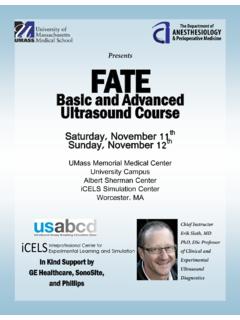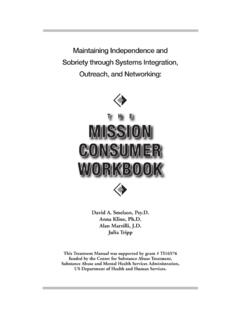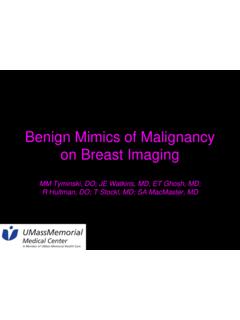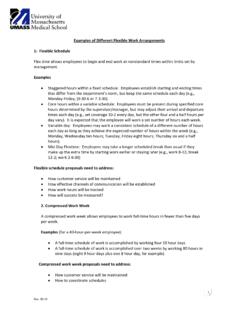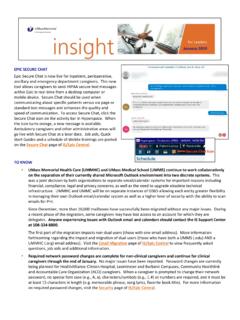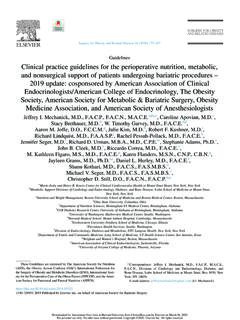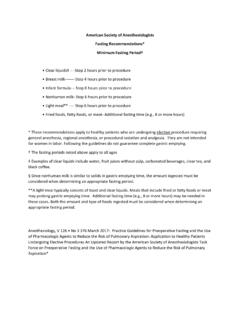Transcription of ICU Residents Guide
1 ICU Residents Guide2014 EditionIntroduction to Learning in theIntensive Care UnitSociety of Critical Care AnesthesiologistsResidents GuideTo Learning in theIntensive Care Unit2014 The information presented in these guidelines was obtained by the Committee on resident Education. The validity of the opinions presented, drug dosages, accuracy and completeness of contents are not guaranteed by 2014 by the society of Critical Care Anesthesiologists, San Francisco, Callifornia. All rights reserved. Contents may not be reproduced without prior written permission of the publisher. Fifth of Critical Care Anesthesiologists 44 Montgomery Street, Suite 1605, San Francisco, CA 94104-4703 iiiPreface iiiContributors viSection 1: Introduction to the ICU 11.
2 Structure, Staffi ng, and Safety 22. Analgesia and Sedation in the ICU 73. Neuromuscular Blockade 104. Transport of the Critically Ill 145. Cardiopulmonary Resuscitation 186. Ethical Issues in the ICU 25 Section 2: Monitoring 297. Routine Monitoring 308. Pulse Wave Monitoring 349. Ultrasound 3710. Point of Care Testing in the ICU 42 Section 3: Neuro Critical Care 4611. Neurocritical Care 4712. Management of Increased ICP 5213. Delirium 56 Section 4: Airway and Pulmonary 6014. Airway Management 6115. Tracheostomy Management 6716. Management of Mechanical Ventilation 7117. Weaning from Mechanical Ventilation 77 Section 5: Shock and Cardiac Management 8118.
3 Management of Shock 8219. Diagnosis and Treatment of Dysrhythmias 8720. Diagnosis and Treatment of Myocardial Ischemia 9121. Valvular Heart Disease 9722. Adult Congenital Heart Disease 10123. Extra-Corporeal Life Support and Ventricular Assist Devices 106 Section 6: Gastroenterology & Nutrition 11124. Gastrointestinal Hemorrhage 11225. Nutritional Support 11626. Acute Pancreatitis 12127. Liver Failure 125 Section 7: Renal and Electrolytes 12928. Acute Renal Failure and Renal Protection 13029. Acid-Base Balance 13430. Electrolyte Abnormalities 14031. Fluid Management in the ICU 14732. Renal Replacement Therapy 151 Section 8: Hematology and Transfusion 15633.
4 Thromboembolic Disease 15734. Coagulopathies in the ICU 16135. Transfusion Therapy 166 Section 9: Infectious Diseases 17336. Severe Sepsis and Septic Shock 17437. Infections and Antibiotic Therapy 17838. Management of the Immunocompromised Patient 186 Section 10: Miscellaneous Topics 19039. Managing Endocrine Emergencies 19140. Toxicology and Support of Patients with Drug Overdoses 19441. Solid Organ Transplantation 20042. Trauma Management in the ICU 21043. Burn Management 21544. Obstetric Critical Care 21945. Management of the Critically Ill Geriatric Patient 222 Answers 225 Table of Contents It is only as we develop others that we permanently succeed.
5 -Harvey S. FirestoneWelcome to critical care. Whether you are using this review Guide for your fi rst rotation in critical care or your tenth, we hope that you fi nd it useful as a supplement to the other reading materials at your delivery of critical care continues to change rapidly. Therapies that were deemed benefi cial in the past (drotrecogin alfa, tight glucose control, etc) are now considered harmful; it is diffi cult to keep up-to-date with textbooks alone. Our goal is to provide concise clinically relevant chapters that are useful for the trainee working in the ICU. Each chapter s relevance is illustrated with a sample case, and the concepts are then reviewed with self-test multiple choice questions.
6 Further in depth learning can be obtained with the selected reference list at the end of each those who grew up with digital media, we have also tried to incorporate new tech-nologies by adding videos, hyperlinks, and , we would like to give our heartfelt gratitude to the many trainees and faculty mentors across the nation who have contributed to this edition and past editions. Without their help and expertise, we would have never succeeded. Thank you to the prior editors as well, for without their vision, we would not be here with the fi fth wishes to the newcomers. May you enjoy the fi eld as much as we B Mahanna, MDDavid W.
7 Shimabukuro, MDCMC hristine A Doyle, MDLinda L. Liu, MDMay 2014 PrefacePreface to the Fourth EditionMany things have changed since the last edition was the most obvious is the name of the society . The society has long had strong international connections, and after deliberating, we changed the name of the organiza-tion to the society of Critical Care Anesthesiologists - SOCCA for short. In the short time since the last edition was published, we have seen a variety of practices fall into and then out of favor, drugs be released and then withdrawn, monitoring tech-nologies proliferate and the electronic health record become an overriding concern for all patient care.
8 Even our options for publication are changing. This is likely to be the last edition that is created as a static electronic document. About half of the authors are new for this edition. Where they have revised older chap-ters, the original authors are again acknowledged at the end of the Afi fi , , IllinoisMiguel Cobas, , FloridaChristine A. Doyle, , CaliforniaPreface to the Third EditionIntensivists have witnessed profound changes in the delivery of critical care medicine in the last decade. A large number of randomized, prospective clinical trials or before and after studies have impacted the way we practice critical care. Examples include the use of drotrecogin alfa activated for the treatment of severe sepsis and septic shock; low tidal volume ventilation in patients with acute lung injury and the acute respiratory distress syndrome; implementation of ventilator and catheter bundles to reduce nosocomial infections; and the use of alpha-2 agonists for sedation of the critically patient.
9 It was clear that the Anesthesiology Residents Guide to Learning in the Intensive Care Unit was in need of revision. We and the american society of Critical Care Anesthesiologists (ASCCA) are pleased to provide this revised Guide to supplement the critical care read-ing material used by anesthesia Residents and third edition has been expanded to include several important topics including Echo-cardiography , Traumatic Brain Injury and Organ Donation and Procurement in the ICU . Similar to the second edition, we have retained the short case presentations and the self-study questions. The reading lists have been majority of the authors who participated in the revision of this edition are new.
10 We would like to thank the previous authors who were either the original authors or who helped revise the second edition. We have acknowledged their contributions at the end of each chapter. The ASCCA is dedicated to timely revisions of this Guide and plans are already underway on the 4th Talmor, O. Heard, to the Second EditionSince the publication date of the fi rst edition in 1995, the scope and practice of critical care medicine have continued to change. Examples of new issues encountered during this time include controversies over pulmonary artery catheter use and pressures over effi cient management of critical care services as managed care demands are realized.

